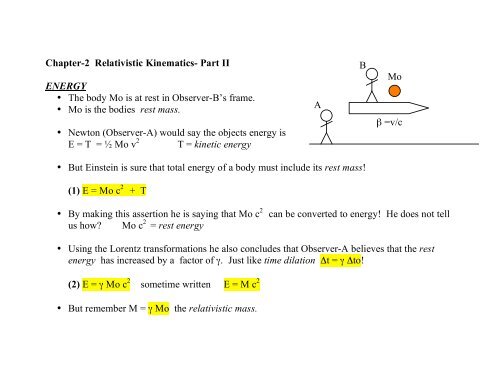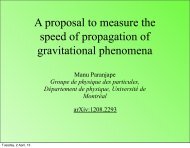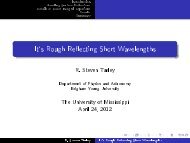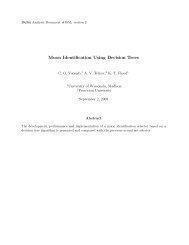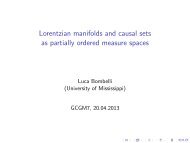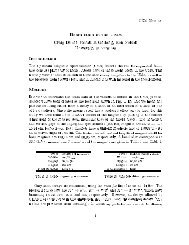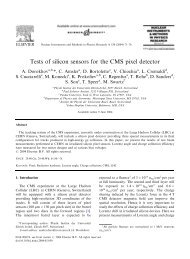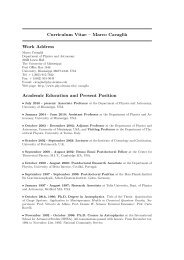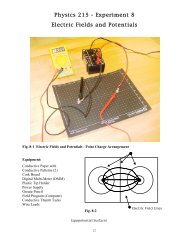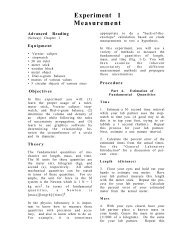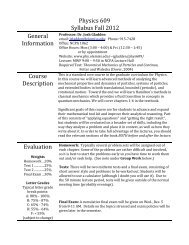Chapter-2 Relativistic Kinematics- Part II ENERGY • The body Mo is ...
Chapter-2 Relativistic Kinematics- Part II ENERGY • The body Mo is ...
Chapter-2 Relativistic Kinematics- Part II ENERGY • The body Mo is ...
You also want an ePaper? Increase the reach of your titles
YUMPU automatically turns print PDFs into web optimized ePapers that Google loves.
<strong>Chapter</strong>-2 <strong>Relativ<strong>is</strong>tic</strong> <strong>Kinematics</strong>- <strong>Part</strong> <strong>II</strong><br />
<strong>ENERGY</strong><br />
<strong>•</strong> <strong>The</strong> <strong>body</strong> <strong>Mo</strong> <strong>is</strong> at rest in Observer-B’s frame.<br />
<strong>•</strong> <strong>Mo</strong> <strong>is</strong> the bodies rest mass.<br />
<strong>•</strong> Newton (Observer-A) would say the objects energy <strong>is</strong><br />
E = T = ½ <strong>Mo</strong> v 2 T = kinetic energy<br />
A<br />
B<br />
<strong>Mo</strong><br />
β =v/c<br />
<strong>•</strong> But Einstein <strong>is</strong> sure that total energy of a <strong>body</strong> must include its rest mass!<br />
(1) E = <strong>Mo</strong> c 2 + T<br />
<strong>•</strong> By making th<strong>is</strong> assertion he <strong>is</strong> saying that <strong>Mo</strong> c 2 can be converted to energy! He does not tell<br />
us how? <strong>Mo</strong> c 2 = rest energy<br />
<strong>•</strong> Using the Lorentz transformations he also concludes that Observer-A believes that the rest<br />
energy has increased by a factor of γ. Just like time dilation Δt = γ Δto!<br />
(2) E = γ <strong>Mo</strong> c 2 sometime written E = M c 2<br />
<strong>•</strong> But remember M = γ <strong>Mo</strong> the relativ<strong>is</strong>tic mass.
MOMENTUM<br />
<strong>•</strong> Observer-A believes that momentum <strong>is</strong> still defined as P = M v !<br />
<strong>•</strong> But M = γ <strong>Mo</strong> must be the new relativ<strong>is</strong>tic mass which Einstein has defined.<br />
(3) P = ( γ <strong>Mo</strong> ) v<br />
MOMENTUM-<strong>ENERGY</strong> TRIANGLE<br />
<strong>•</strong><br />
One can show that<br />
(4) E 2 = P 2 c 2 + <strong>Mo</strong> 2 c 4<br />
E 2 P 2 c 2<br />
<strong>Mo</strong> 2 c 4<br />
(1) E = <strong>Mo</strong> c 2 + T<br />
(2) E = γ <strong>Mo</strong> c 2<br />
(3) P = ( γ <strong>Mo</strong> ) v<br />
(4) E 2 = P 2 c 2 + <strong>Mo</strong> 2 c 4<br />
SUMMARY
ELECTRON VOLT UNITS<br />
In order to speed up calculations and reduce confusion scient<strong>is</strong>t generally use electon-volt as the<br />
standard unit of energy in atomic and nuclear physics.<br />
1 eV = (1.6x10 -19 C ) ( 1V) = 1.6x10 -19 J<br />
1 eV = 1.6x10 -19 J<br />
E eV<br />
P eV/c<br />
M eV/c 2 Me = 0.511 MeV/ c 2<br />
Mp = 938.3 MeV/ c 2<br />
Mn = 939.6 MeV/ c 2<br />
EXAMPLE 2.3<br />
An electron a speed v = 0.85c . What <strong>is</strong> its total energy and kinetic energy in electron-volts.<br />
γ = 1/sqrt(1-0.85^2) = 1.9<br />
E = γ <strong>Mo</strong> c 2 = (1.9)( 0.511 MeV/ c 2 ) c 2<br />
= 0.97 MeV<br />
T = E – <strong>Mo</strong> c 2 = 0.97 – 0.511 = 0.46 MeV<br />
E = <strong>Mo</strong> c 2 + T<br />
E = γ <strong>Mo</strong> c 2<br />
P = γ <strong>Mo</strong> v<br />
E 2 = P 2 c 2 + <strong>Mo</strong> 2 c 4
EXAMPLE 2.4<br />
<strong>The</strong> total energy of a proton <strong>is</strong> three time its rest energy.<br />
(a) Find the proton’s rest energy. Mpc 2 = 938.3 MeV<br />
E = <strong>Mo</strong> c 2 + T<br />
E = γ <strong>Mo</strong> c 2<br />
P = γ <strong>Mo</strong> v<br />
E 2 = P 2 c 2 + <strong>Mo</strong> 2 c 4<br />
(b)<br />
What <strong>is</strong> the proton’s speed?<br />
P/E = v/c 2 or v/c =P/E c<br />
E = 3 x 938.3 MeV = 2815 MeV<br />
P = sqrt( E 2 - <strong>Mo</strong> 2 c 4 ) = sqrt(2815 2 - 938 2 ) = 2653 MeV/c<br />
v/c = (2653 MeV/c ) / (1876MeV)c = 0.94<br />
v = 0.94c<br />
(c) Find the kinetic energy of the proton.<br />
T = E - <strong>Mo</strong> c 2 = 2815 –938 = 1876 MeV<br />
(d) What <strong>is</strong> the proton’s momentum?<br />
P = 2653 MeV/c
MASS DEFICIT<br />
ΔM<br />
<strong>•</strong> Consider the reaction A --> B + C where A <strong>is</strong> at rest. T A =0<br />
<strong>•</strong> From the Conservation of Energy<br />
E(A) = E(B) + E(C)<br />
M A c 2 + T A = M B c 2 + T B + M C c 2 + T C<br />
Q = T A +T B +T C = M A c 2 - M B c 2 – M C c 2<br />
Q = (M A - M B – M C ) c 2<br />
ΔM = M A - M B – M C<br />
Energy Deficit or D<strong>is</strong>intergration Energy<br />
Q-value=excess kinetic energy<br />
Mass Deficit<br />
<strong>•</strong> If Q > 0 then the reaction <strong>is</strong> exothermic.<br />
<strong>Part</strong>icles B and C share the excess energy and go flying apart.<br />
<strong>•</strong> If Q < 0 the reaction <strong>is</strong> endothermic.<br />
It will not proceed without adding energy of at least >Q.
A X Z<br />
ATOMIC MASS UNIT<br />
<strong>The</strong> mass of an atom <strong>is</strong> often given in atomic mass units (u).<br />
A = atomic number = N + Z = # neutrons +# protons<br />
Z = # protons<br />
1 u = M( 12 C 6 ) /12. = 931.5 MeV/c 2<br />
EXAMPLE 2.7<br />
F<strong>is</strong>sion Reaction<br />
236 U 92 --> 143 Cs 55 + 90 Rb 37 + 3 1 n 0<br />
ΔM = M(U) – M(Cs) – M(Rb) – M(3 n) = 0.177537 u<br />
Q = ΔM c 2 = 0.177537 u x 931.5 MeV = 165.4 MeV<br />
mass deficit<br />
released per U f<strong>is</strong>sion!<br />
1 kg of 236 U = 2.55 x 10 24 atoms<br />
1 kg of 236 U 2.55 x 10 24 atoms x 165.4 MeV = 7,500 Mwh<br />
100W light bulb for 8500 yrs !
BINDING <strong>ENERGY</strong> of STABLE NUCLEI<br />
N+Z X Z<br />
<strong>•</strong> <strong>The</strong> mass of a stable nucleus <strong>is</strong> always less than the mass of its constituents.<br />
Th<strong>is</strong> lesser amount <strong>is</strong> called the binding energy BE.<br />
Mc 2 =<br />
n<br />
" m i=1 i<br />
c 2 - |BE|<br />
<strong>•</strong> To separate the nucleus in to its constituents we must supply or overcome th<strong>is</strong> binding energy.<br />
!<br />
Q = M( A X Z ) - Z Mp - N Mn – Z Me < 0 = -|BE|<br />
<strong>•</strong> <strong>The</strong> binding energy of a hydrogen atom <strong>is</strong> 13.6 eV.


